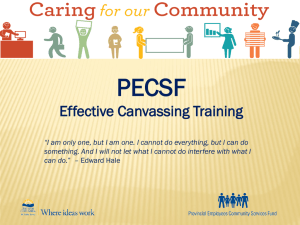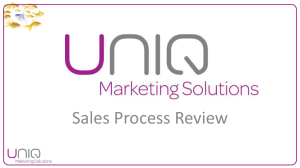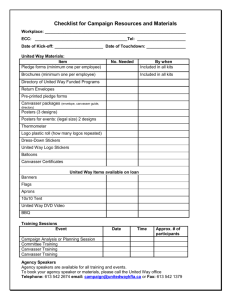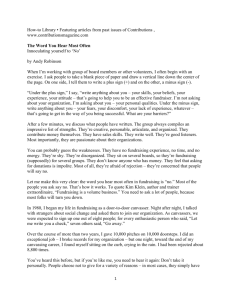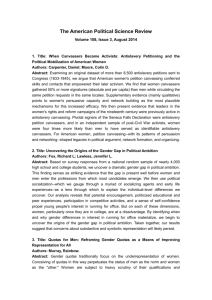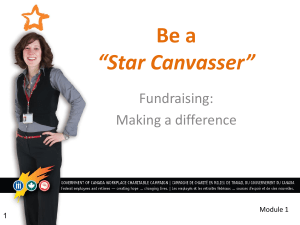List of questions to inform canvass planning
advertisement
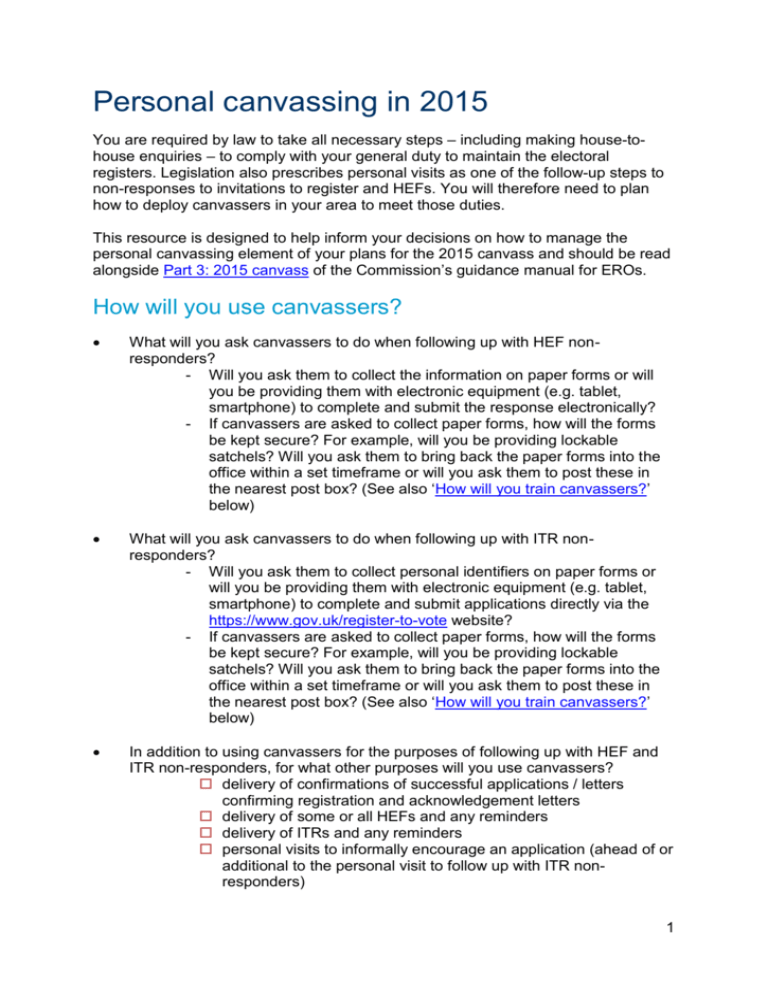
Personal canvassing in 2015 You are required by law to take all necessary steps – including making house-tohouse enquiries – to comply with your general duty to maintain the electoral registers. Legislation also prescribes personal visits as one of the follow-up steps to non-responses to invitations to register and HEFs. You will therefore need to plan how to deploy canvassers in your area to meet those duties. This resource is designed to help inform your decisions on how to manage the personal canvassing element of your plans for the 2015 canvass and should be read alongside Part 3: 2015 canvass of the Commission’s guidance manual for EROs. How will you use canvassers? What will you ask canvassers to do when following up with HEF nonresponders? - Will you ask them to collect the information on paper forms or will you be providing them with electronic equipment (e.g. tablet, smartphone) to complete and submit the response electronically? - If canvassers are asked to collect paper forms, how will the forms be kept secure? For example, will you be providing lockable satchels? Will you ask them to bring back the paper forms into the office within a set timeframe or will you ask them to post these in the nearest post box? (See also ‘How will you train canvassers?’ below) What will you ask canvassers to do when following up with ITR nonresponders? - Will you ask them to collect personal identifiers on paper forms or will you be providing them with electronic equipment (e.g. tablet, smartphone) to complete and submit applications directly via the https://www.gov.uk/register-to-vote website? - If canvassers are asked to collect paper forms, how will the forms be kept secure? For example, will you be providing lockable satchels? Will you ask them to bring back the paper forms into the office within a set timeframe or will you ask them to post these in the nearest post box? (See also ‘How will you train canvassers?’ below) In addition to using canvassers for the purposes of following up with HEF and ITR non-responders, for what other purposes will you use canvassers? delivery of confirmations of successful applications / letters confirming registration and acknowledgement letters delivery of some or all HEFs and any reminders delivery of ITRs and any reminders personal visits to informally encourage an application (ahead of or additional to the personal visit to follow up with ITR nonresponders) 1 Will you use different canvassers for different parts of the process? For example: - Are there types of properties you would prefer more experienced canvassers or core electoral services staff to visit, such as households with unconfirmed electors, residential care homes, student halls or houses in multiple occupation - drawing on your public engagement strategy on how best to reach potential electors? - Will the same canvassers be used to follow up HEFs and ITRs? Will there be different parts of the process that would benefit from being carried out simultaneously by the same canvasser? For example: - If you are using a canvasser to deliver a HEF, could you use the same canvasser to encourage doorstep completion of the form? - If you have identified potential electors, do you want to use canvassers to informally encourage an application if they are already deployed in the area anyway? - Equally, if you are using a canvasser to deliver the first ITR, could you use the same canvasser to encourage doorstep completion of the form? How will you communicate responses and any other relevant information to canvassers in a timely way to prevent unnecessary visits or alert them to any additional visits or other parts of the process you would like them to carry out while they are deployed? How many canvassers will you need and how do the purposes for which you will be using canvassers affect recruitment? See also our canvassing recruitment and training checklist for considerations on the recruitment process. How many canvassers will you need? - What is the scale of the activity you’ll be asking canvassers to undertake? o What will you be using canvassers for? (see above) o What does your revised public engagement strategy tell you about the level of personal canvassing you will likely need to carry out during the canvass? How will this help you determine canvasser rounds? How will the purposes for which you will be using canvassers affect canvasser recruitment? - Canvassing is a year-round process under IER, but are there particular times when you envisage requiring a larger number of canvassers? 2 - How many hours will canvassers likely need to work to complete the necessary personal visits? How will canvasser duties affect canvasser pay? How will the purposes for which you are deploying canvassers impact on the required skill set and canvasser job descriptions? When will you need to have finalised your job description so you can complete canvasser recruitment in good time and ensure canvassers are appropriately trained? How will canvassers be recruited? For example: - How will you recruit and appoint canvassers for the canvass and the year-round personal visits? - Have you considered liaising with neighbouring authorities for the purposes of sharing canvassers? How will you train canvassers? See our canvassing recruitment and training checklist for specific training considerations . If you’re using different canvassers for different purposes, will you need to carry out separate training sessions? Will this affect the training materials you need? For example: - To what extent will you need to adapt the Commission’s canvasser training presentation? If you are providing canvassers with a smartphone or tablet, how will you ensure canvassers are confident in their operation – for example, will you need to set aside some time at the training session for practical demonstrations? Also, will this affect any guidance you give canvassers on health and safety, given they may be carrying high-value equipment? Given the sensitive nature of the information collected by canvassers, how will you ensure that canvassers are aware of their responsibilities and keep forms and any personal data secure? Safety and risk Have you carried out risk assessments for individual properties where there could be a risk to a canvasser’s personal safety? What is your council’s lone working policy? Have you sought the assistance of those with experience of administering and using the policy in order to ensure that all risks to personal safety are considered and that appropriate measures are put in place to ensure the safety of the canvassers? Have you included the health and safety of personal canvassers in your risk register and identified any corresponding mitigating actions? 3
